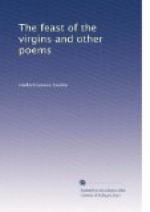E-ne-pee—vapor-bath, is used as a purification preparatory to the sacred feasts. The vapor-bath is taken in this way: “A number of poles, the size of hoop-poles or less, are taken, and their larger ends being set in the ground in a circle, the flexible tops are bent over and tied in the center. This frame-work is then covered with robes and blankets, a small hole being left on one side for an entrance. Before the door a fire is built, and round stones about the size of a man’s head, are heated in it. When hot they are rolled within, and the door being closed steam is made by pouring water on them. The devotee, stripped to the skin, sits within this steam-tight dome, sweating profusely at every pore, until he is nearly suffocated. Sometimes a number engage in it together and unite their prayers and songs.” Tahkoo Wakan, p. 83. Father Hennepin was subjected to the vapor-bath at Mille Lacs by Chief Aqui-pa-que-tin, two hundred years ago. After describing the method, Hennepin says: “When he had made me sweat thus three times in a week, I felt as strong as ever.” Shea’s Hennepin, p. 228. For a very full and accurate account of the Medicine-men of the Dakotas, and their rites, etc., see Chap. II, Neill’s Hist. Minnesota.
[82] The sacred O-zu-ha—or Medicine sack must be made of the skin of the otter, the coon, the weasel, the squirrel, the loon, a certain kind of fish or the skins of serpents. It must contain four kinds of medicine (or magic) representing birds, beasts, herbs and trees, viz.: The down of the female swan colored red, the roots of certain grasses, bark from the roots of cedar trees, and hair of the buffalo. “From this combination proceeds a Wakan influence so powerful that no human being, unassisted, can resist it.” Wonderful indeed must be the magic power of these Dakota Druids to lead such a man as the Rev. S.R. Riggs to say of them: “By great shrewdness, untiring industry, and more or less of actual demoniacal possession, they convince great numbers of their fellows, and in the process are convinced themselves of their sacred character and office.” Tahkoo Wakan, pp. 88-9.
[83] Gah-ma-na-tek-wahk—the river of many falls—is the Ojibway name of the river commonly called Kaministiguia, near the mouth of which is situated Fort William. The view on Thunder-Bay is one of the grandest in America. Thunder-Cap, with its sleeping stone-giant, looms up into the heavens. Here Ka-be-bon-ikka—the Ojibway’s god of storms—flaps his huge wings and makes the Thunder. From this mountain he sends forth the rain, the snow, the hail, the lightning and the tempest. A vast giant, turned to stone by his magic, lies asleep at his feet. The island called by the Ojibways the Mak-i-nak (the turtle) from its tortoise-like shape, lifts its huge form in the distance. Some “down-east Yankee” called it “Pie-island,” from its fancied resemblance to a pumpkin pie, and the name, like all bad names, sticks. McKay’s Mountain on the mainland, a perpendicular rock more than a thousand feet high, upheaved by the throes of some vast volcano, and numerous other bold and precipitous headlands, and rock-built islands, around which roll the sapphire-blue waters of the fathomless bay, present some of the most magnificent views to be found on either continent.




